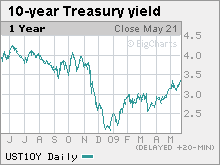Treasurys turn lower
Government debt prices extend previous day's losses, sending yields to 6-month highs, as market braces for supply shock.
NEW YORK (CNNMoney.com) -- Treasury prices fell Friday, extending sharp losses from the previous session and pushing longer-term yields to six-month highs, as investors fretted about pending debt sales next week.
Trading was expected to be light ahead of a holiday weekend. The bond market closed early Friday and will be shut Monday in observance of Memorial Day.
An onslaught of debt supply has weighed on the Treasury market throughout the government's effort to restart the recovery.
"The combination of the collapse of tax receipts and the monolithic fiscal stimulus has skyrocketed government borrowing globally," said Nick Kalivas, vice president of financial research at MF Global, in a research note.
On Thursday, the Treasury announced that it will auction $40 billion in 2-year notes, $35 billion in 5-year notes and $26 billion in 7-year notes next week. That $101 billion in notes is on top of shorter-term debt also in the pipelines.
"Treasuries opened higher, then sold off hard as traders are a little nervous about going home too long before the holiday knowing that they come in next week to a lot of new supply," said Kevin Giddis, managing director of fixed income at Morgan Keegan, in a daily research note.
In an effort to keep government debt yields from jumping too high, the government continues to move forward with its $300 billion debt buyback plan. The Treasury bought $7.4 billion worth of debt Thursday after a purchase operation totaling $7.7 billion Wednesday. The Fed will continue purchasing debt next week.
Anxiety about the sustainability of U.S. creditworthiness also added to the decline in government debt prices Friday. A report Thursday from Standard & Poor's confirmed the United Kingdom's top-notch credit rating, but lowered its outlook for the nation to "negative" from "stable." The agency cited fears that Britain's debt burden could reach 100% of its gross domestic product.
Treasurys sold off Thursday on fears that the United States could face a similar fate, given the pace at which the government is taking on debt to prop up the economy. The 30-year bond sank more than 2-1/2 points Thursday.
"The thinking is that many fear the U.S. is next on S&P's chopping block," said Kalivas. "These fears to a certain degree do make sense ... as similarities between the U.S. and U.K.'s economies are great."
One analyst said that the S&P report would likely contribute to increase price sensitivity. "The S&P story about its concern about the AAA rating of sovereign debt, specifically the U.K.'s, thus bringing into question the AAA rating of the U.S., has added a lot of volatility to the current market," said Giddis.
Meanwhile, the Federal Reserve's most recent outlook for the economy, released Wednesday, was more dour than its last. The grim forecast kept a floor under losses in the debt market, as some investors' risk appetite dried up a bit.
Bond prices: The benchmark 10-year note fell 21/32 to 97-10/32, and its yield jumped to 3.45%, the highest yield since mid-November. Bond prices and yields move in opposite directions
The 30-year bond sank 1-4/32 to 97-26/32, and its yield rose to 4.39%, also the highest level since mid-November.
The 2-year note fell 2/32 to 99-31/32, and its yield rose to 0.90% from 0.86%.
The yield on the 3-month note held steady at 0.18%.
Lending rates: A key bank-to-bank lending rate held steady at an all-time low, a positive sign for the health of the credit markets. The 3-month Libor was unchanged at 0.66%, according to Bloomberg.com.
The overnight Libor rate, however, ticked up slightly to 0.23% Friday from 0.22%.
Libor, the London Interbank Offered Rate, is a daily average of rates that 16 different banks charge each other to lend money in London. The closely watched benchmark is used to calculate adjustable-rate mortgages. More than $350 trillion in assets are tied to Libor. ![]()



